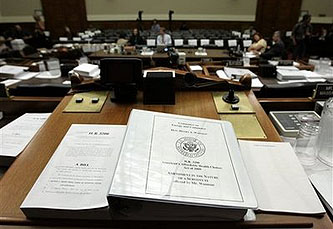 On an ABC news segment about healthcare tonight, Jonathan Karl said, “Democrats in the Senate are more optimistic on this than I have seen them in a long time.” Why? Because they think they’ve struck a deal that can get 60 votes. Most reports I’ve seen agree on the basics, including this one from Brian Beutler:
On an ABC news segment about healthcare tonight, Jonathan Karl said, “Democrats in the Senate are more optimistic on this than I have seen them in a long time.” Why? Because they think they’ve struck a deal that can get 60 votes. Most reports I’ve seen agree on the basics, including this one from Brian Beutler:
As has been widely reported, one of the trade-offs will be to extend a version of the Federal Employees Health Benefits Plan to consumers in the exchanges. Insurance companies will have the option of creating nationally-based non-profit insurance plans that would offered on the exchanges in every state. However, according to the aide, if insurance companies don’t step up to the plate to offer such plans, that will trigger a national public option.
Beyond that, the group agreed — contingent upon CBO analysis — to a Medicare buy in.
That buy-in option would initially be made available to uninsured people aged 55-64 in 2011, three years before the exchanges open. For the period between 2011 and 2014, when the exchanges do open, the Medicare option will not be subsidized — people will have to pay in without federal premium assistance — and so will likely be quite expensive, the aide noted. However, after the exchanges launch, the Medicare option would be offered in the exchanges, where people could pay into it with their subsidies.
It appears as if liberals lost out on a Medicaid expansion that would have opened the program up to everybody under 150 percent of the poverty line. That ceiling will likely remain at 133 percent, as is called for in the current bill.
In addition to the new insurance options, the group has tentatively agreed to new, and strengthened, insurance regulations, which the aide could not divulge at this time.
So: an OPM-administered national plan, a weak triggered public option, a limited Medicare buy-in between 55-64, and some new insurance regs. If this sticks, it’s actually better than I expected. I always figured we’d get a triggered public option and nothing more.
Of course, this still has a long way to go, and abortion is still a sticking point. But for now, the prospects for healthcare reform are looking as good as they ever have. Keep your fingers crossed.

















